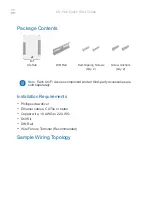
7. Programmer’s Reference
MX-FR Series Modular Matrix Frames – User's Manual
142
Applied CPU2 firmware: v3.5.7b8 | LDC software: v2.5.17b2
ASCII
When the router receives a message, the next message will be sent to the controllers:
Ȩ
(S#In=[received text])
or
Ȩ
(S#On=[received text])
where
n
is the port number, I is the input, and O is the output port. See the example:
Far endpoint sends: Simple math: 2\[3-(2+8)]. Solve it!
The router sends:
Ȩ
(S#I1=Simple math: 2\\[3-\x282+8\x29]. Solve it!)
The received data is represented as plain ASCII text and the maximum length of it is 54 bytes. The ( and
) characters are frame delimiters, so they cannot be inside a message. Therefore all ( characters will be
replaced to \x28, while all ) will be replaced to \x29 escape sequences, while \ will be escaped as \\. No other
characters will be escaped. If the programmer of the controller does not want to parse escape sequences (it
is in fact just a sprintf(...) function call), the Binary mode should be used.
Binary
Ȩ
(B#In=[received text as binary data, e.g. 736F6D657468696E67])
or
Ȩ
(B#On=[received text as binary data, eg. 736F6D657468696E67])
where
n
is the port number, I is the input, and O is the output port.
The received text is translated to binary form. The maximum length of the received text is 54 bytes, so the
length of the hex data can be up to 108 characters. See the example:
Far endpoint connected to input port 1 is sending data, the router sends:
Ȩ
(B#I1=736F6D657468696E67)
7.12.3. Querying the Serial Parameters
The properties of the serial pass-through can be queried on the input and the output side.
Command and Response
ȩ
{:SERIAL#
<in2/out2>
@
<S>
I/O=?}
Ȩ
(SERIAL#
<in2/out2>
@
<S>
I/O=
<a>
;
<b>
;
<c>
;
<d>
)CrLF
Example
ȩ
{:serial#24@so=?}
Ȩ
(SERIAL#24@SO=1;9600;1;1)CrLf
Serial pass-through sending and receiving is enabled on the 24th output port with 9600 baud.
Parameters
Identifier
Parameter Description
Parameter Values
Read/write parameters
<
in2
>/<
out2
> Input or output port number Port number in 1- or 2-digit ASCII format (01, 3, 04, etc.)
<
I/O
>
Input or output port type
I
= input,
O
= output
<
a
>
Receiving is enabled
0
: Incoming data is rejected.
1
: The incoming data is sent to the controllers in ASCII
mode. (default)
2
: The incoming data is sent to the controllers in HEX mode.
<
b
>
Current baud rate
9600 (default), 14400, 19200, 38400, 57600
<
c
>
Serial pass-through enable
1
: enabled,
0
: disabled
Read-only parameter
<
d
>
The presence of a serial
pass-through capable device
1
: Serial link is active
0
: There is no active serial link
7.12.4.
Setting the Serial Parameters
The properties of the serial pass-through can be modified on the input and the output side.
Command and Response
ȩ
{:SERIAL#
<in2/out2>
@
<S>
I/O=
<a>
;
<b>
;
<c>
;
<d>
}
Ȩ
(SERIAL#
<in2/out2>
@
<S>
I/O=
<a>
;
<b>
;
<c>
;
<d>
)CrLf
Example
ȩ
{:serial#24@so=1;9600;1;1}
Ȩ
(SERIAL#24@SO=1;9600;1;1)CrLf
Serial pass-through sending and receiving is enabled on the 24th output port with 9600 baud.
Parameters
See the previous section.
















































